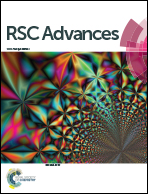Synthesis of microencapsulated benzyl benzoate with a CaCO3 shell and its application to the durable anti-mite finishing of nylon 6 fabric
Abstract
Microcapsules based on the benzyl benzoate core and CaCO3 shell were synthesized via an interfacial co-precipitation method and used to treat nylon 6 fabric to impart anti-mite activity. The results of FTIR, SEM and upright metallurgical microscopy confirmed that the benzyl benzoate was successfully encapsulated by the CaCO3 shell. The morphologies, particle size distribution, encapsulation ratio and encapsulation efficiency of the microcapsules were investigated systematically. The nylon 6 fabric was treated with the resultant microcapsules via a finishing process and the microcapsules were immobilized on the surface of the nylon 6 fabric with chemical bonds, by using a blocked waterborne PU adhesive. The morphology of the treated fabric was investigated by SEM and the benzyl benzoate content determined by UV-vis spectrophotometry. The mite repellent tests showed that the treated nylon 6 fabric exhibited excellent anti-mite properties and laundering durability, and the mite repellent rate was up to 82.3% and remained at 61.8% after being washed 20 times.


 Please wait while we load your content...
Please wait while we load your content...